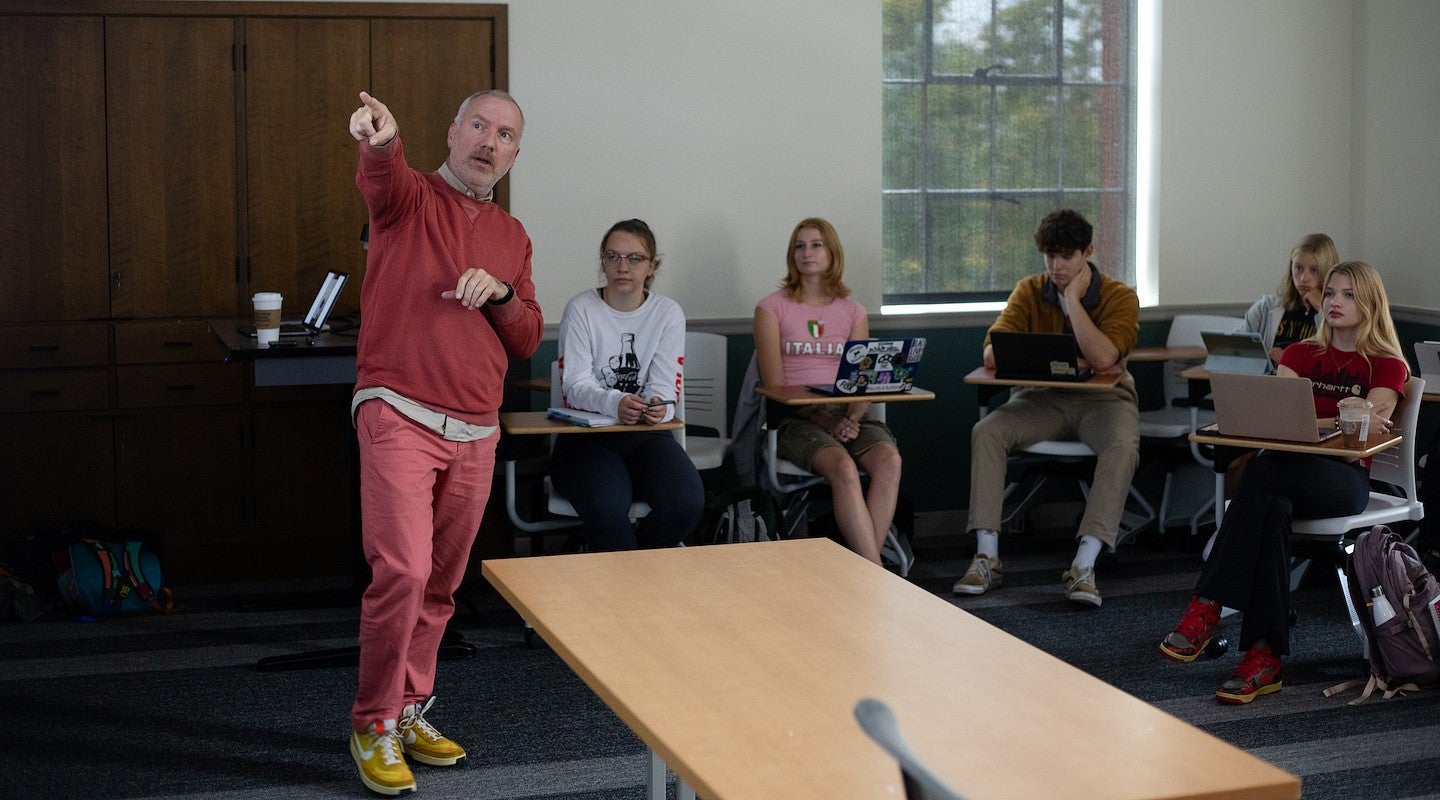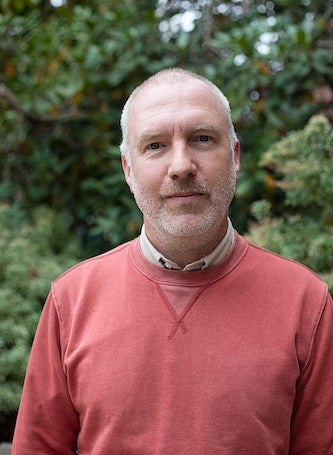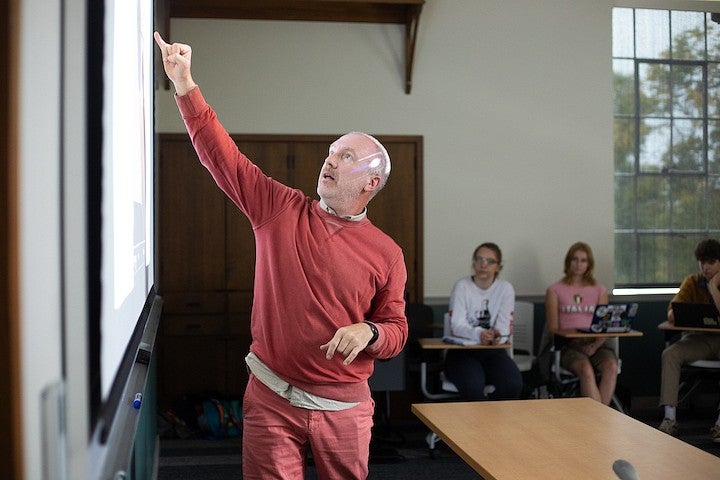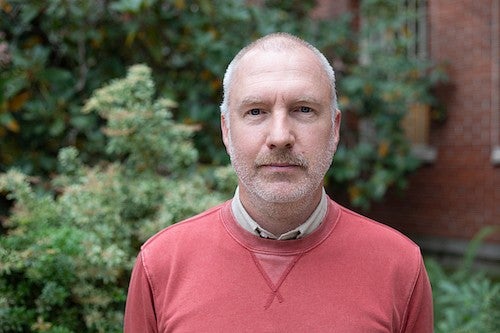
Wading through the slime

Coffee or tea: Coffee, usually an Americano first thing in the morning.
Favorite movie: I tend to watch the same movie over and over. My current movie is Blade Runner 2049. I’m drawn to dystopian sci-fi as a genre.
Favorite musical artist: Recently, I’ve been listening to a lot of Big Thief, Chromatics, Crystal Castles, The Magnetic Fields, The Smiths.
Favorite outdoor activity: I love skiing with my family. In the summers, we live on our sailboat in the San Juans because Eugene is just too hot.
Snack for the art studio: I love very crunchy snacks. The crunchier the better. For whatever reason, crunchy food makes me especially productive in the studio.
Christopher Michlig bounces between small groups of students in Lawrence Hall Room 143 as they discuss one of their first readings for his 400-level class, “Slime and Sliminess.” There’s a general hum of first-week excitement in the room, and students express disbelief at their professor’s passion for slime as a substance.
Michlig is a new core faculty member in the Clark Honors College this fall. He is also teaching “12,000 Colors.” His experiences in academia, his background as an artist, and his passion for analyzing the overlooked pushed him to break tradition in the classroom.
For Michlig, things have always been a work in progress. From a childhood in small-town Alaska to his days in dusty and smoggy Los Angeles, he is constantly evolving as an artist and teacher. His newest book allowed him to explore the evolution of another everchanging substance: slime.
“I love niche moments in art history that got passed over or artistic movements that ended too abruptly,” Michlig says. “I like trying to follow up on those loose ends in history and culture – that's my thing.”
In pursuit of an education
Michlig grew up in Girdwood, Alaska, a ski resort town with a small population of year-round residents. Thinking about Alaska, images of wide-open tundra, plains and grizzly bears come to mind. Michlig remembers those things, but also the neon plastics of ski culture and the solitude of his youth, both of which influence his art today. “I don’t think Alaska itself is visible in my art, but it did shape my creative process in a way,” he says.
The way Michlig tells it, hitting the slopes was one of the only things to do. Girdwood didn’t have a high school, so he faced three options when he graduated from his small primary school: take the bus for three hours to Anchorage for school, go to boarding school, or go to the ski academy in Girdwood.
He chose Portland for boarding school, although he would have preferred the ski academy at the time. “It had the curriculum of a high school but what was mainly happening was that people were training skiing for 10 to 12 hours a day,” he recalls. “That’s what I wanted to do, but my family said no.”


Michlig wears color-coordinated outfits when he teaches about the creative concepts around ROYGBIV – red, orange, yellow, green, blue, indigo and violet.
Michlig had a teacher in boarding school who informed how he teaches his classes today. “I took an English class when I was a junior or a senior,” he says. “I did all the reading, but I didn’t find the class very engaging.”
The teacher had past issues of The New Yorker stacked in the back of her classroom, about three feet high. “I sat in the back, and while class discussions were happening, I would just read back issues of the New Yorker,” he remembers with a laugh. “By the end of the semester, I had learned so much through that passive experience.”
When Michlig ran into that same teacher 25 years later, he thanked her for teaching the class. “She said she knew what I was doing but didn’t mind because she knew I was learning another way,” he says. “I like the idea that students can engage in different ways, and that engagement looks different for everyone.”
Permission to embrace art
Michlig continued his education at the University of Oregon, becoming the first person in his family to graduate from college.
“When I was a student, I originally had a very conventional idea of how a particular area of study relates to a job,” he says, noting that he switched his major from sociology to printmaking when he had a drawing professor open his eyes to new possibilities.
“She said ‘There’s no reason you can’t take a drawing class as seriously as an organic chemistry class that a pre-med student is taking,’” he recalls her telling him. “That idea had never occurred to me, and it totally opened up my mind.”
“When I was a student, I originally had a very conventional idea of how a particular area of study relates to a job. A drawing professor told me, ‘There’s no reason you can’t take a drawing class as seriously as an organic chemistry class that a pre-med student is taking.’ That idea had never occurred to me, and it totally opened up my mind. I realized that I’ve always identified as a creative person. That moment was just the first time I gave myself permission to take it really seriously.”
Michlig moved to Los Angeles after graduation and lived there for five years, getting to know other artists and galleries and exploring what was possible within the art world. “It wasn’t until 2004, when I went to graduate school at ArtCenter College of Design in Pasadena, that I started considering myself an artist,” he says.
The graduate program at ArtCenter was highly intensive. He was in the studio for 30 to 40 hours a week, making art and building creative momentum. “I still feel like I have that momentum, that drive to make things and look at things and turn them inside out and analyze them,” he says.
Breaking tradition in the classroom
After graduate school, Michlig returned to Eugene and started teaching at UO. The great instructors that he had during his time in school inspired him to become a professor, and he feels at home in the innovative teaching and research environment offered at the Honors College.
“I think it is in my nature to research and then interpret and respond - either through reading or writing, looking at art and then working in the studio,” he says. “Academia is a very natural place for me to be; I feel like it’s my natural habitat, in a way.”
Today, Michlig continues the thread of breaking tradition in the classroom. His 400-level class about slime is a student-forward experience that explores the phenomenon through science fiction, literature, critical theory, and cinema.
The way he engages with his students, you’d think he was one of them. He meanders around the horseshoe of tables in his classroom, getting down on his knees to talk to students on their level. “One of the things that inspired me to be in the Honors College was wanting to experience new things, and to tangibly experience personal growth,” Michlig says. “I want to grow with students while they’re having new experiences.”

He noted that Acting Dean Carol Stabile and Associate Dean of Undergraduate Studies Daphne Gallagher have been helpful with that. “I don’t want to pull a class off the shelf that was fully formed,” he says. “I want to do new things, and Carol and Daphne are so supportive of that.”
Stabile considers Michlig to be a leader for what he does for students. He is “bringing art practice and thinking like an artist to the Honors College,” she says. “As far as I know, he’s the first faculty member here to do that.”
Michlig makes sure that the classroom is a student-forward experience by appointing discussion leaders to conduct class instead of following the traditional lecture format. “Ideally, there is a breakdown of the professor-student relationship in the classroom, and I really like being able to learn from students as they learn from me,” he says. “It shouldn’t be a one-way street.”
His infatuation with slime, which led to the class “Slime and Sliminess,” was born from a lecture he gave in 2017. He thought his talk would be a one-off passion project, but afterward, a graduate student approached him and asked when his book on slime would be published. That started his journey to publishing his manuscript: “File Under: Slime”
“File Under: Slime” is a chronological order of different instances of slime in popular culture, all organized into a booklet. The experience of flipping through the book is similar to exploring a file cabinet full of slime files.
Michlig names his favorite type of slime as black and gooey, like in Paradise Lost or the La Brea Tar Pits. “Every time I’m in LA, I love to go to the George C. Page Museum with the kids and get a stick to poke the slime,” he said. “It’s irresistible.”
One of his favorite things about his class is that a lot of the subject remains unexplored. “I tell students: I don’t have all the information, but let’s work on it together,” Michlig says. “It’s kind of an invitation for something new.”
